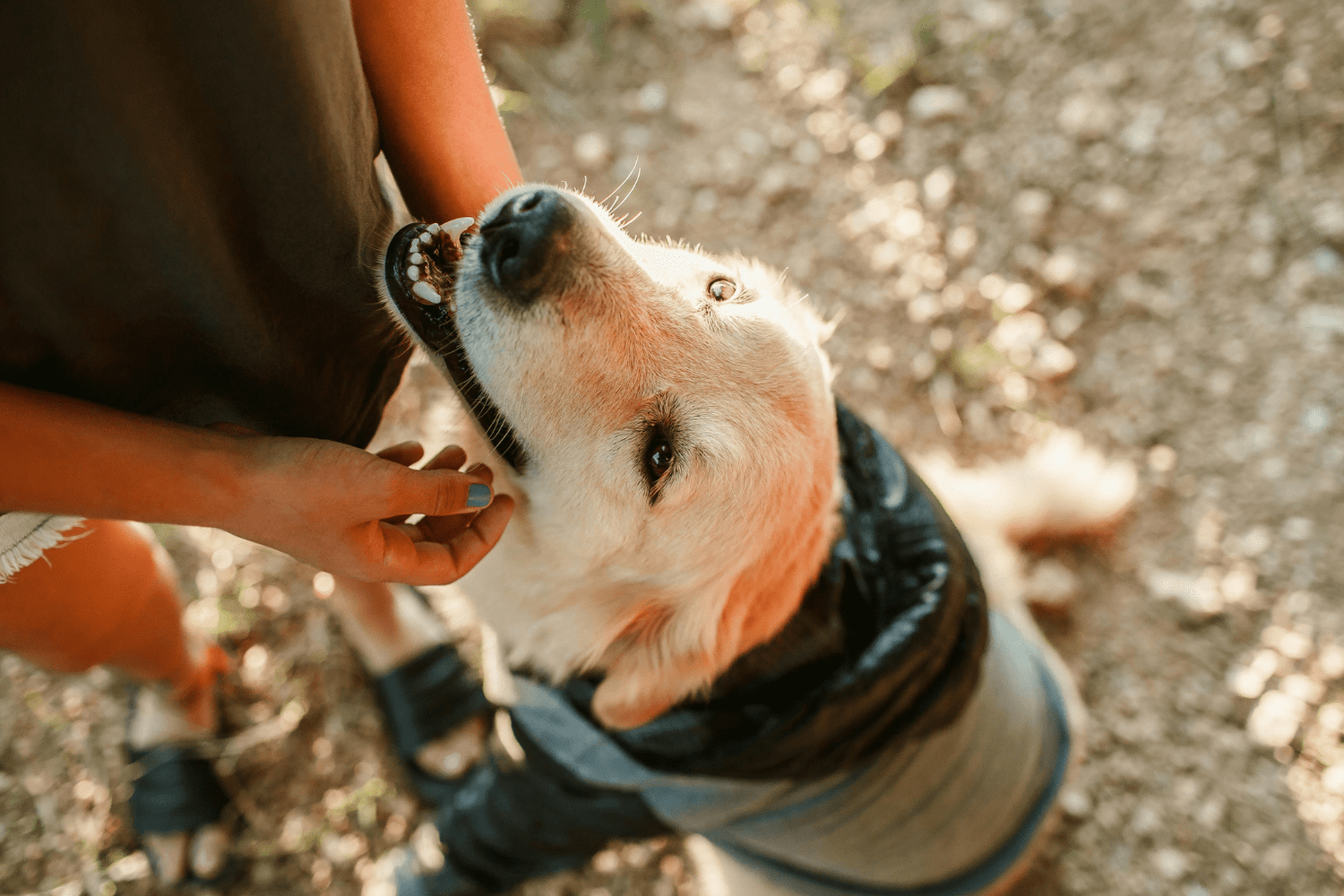Key Takeaways
- Dog skin tags are common and usually harmless growths found on dogs of all ages.
- These soft, fleshy bumps often appear on senior dogs but are generally benign.
- Finding a skin tag on your dog is typically not a cause for immediate concern.
- Dog skin tags are benign skin overgrowths that do not pose a threat to your pet.
Table of Contents
- What Are Dog Skin Tags? The Basics Every Pet Parent Should Know
- Why Do Dogs Get Skin Tags? Understanding the Common Triggers
- How to Tell If It's Really a Skin Tag, Not Something More Serious
- When (and How) Skin Tags Should Be Removed
- Supporting Your Dog's Skin Health Naturally
- Over-the-Counter vs. Professional Care: Choosing What's Best for Your Pet
- Natural Support & Skin Health: Holistic Ways to Help Your Dog Thrive
- Preventing Irritation & Future Skin Tags: Everyday Best Practices
- Troubleshooting: What If...? Real Solutions for Common Skin Tag Problems
- Your Next Best Step: Helping Your Dog Live Comfortably with Skin Tags
- Professional vs. Natural Care: Choosing What's Best for Your Pet
Dog Skin Tags: When to Worry & How to Help
Finding a mysterious bump on your dog can send any pet parent into worry mode. But before you spiral, know this: dog skin tags are incredibly common, usually harmless growths that affect dogs of all ages, especially our senior pups. These soft, fleshy bumps might look alarming, but they're typically just benign skin overgrowths that pose no threat to your furry family member.
The key is knowing when a skin tag is just a skin tag, versus when it might be something that needs your vet's attention. Let's walk through everything you need to recognize, monitor, and care for these common growths, so you can stop worrying and start helping your dog live their most comfortable life. Dog Hepatic Liver Support Remedy can be a beneficial addition for dogs whose skin health may be impacted by underlying liver function, supporting overall wellness as you monitor skin changes.
For more insights into related canine health concerns, you might also find it helpful to read about dog red eyes and how to address them alongside skin issues.
What Are Dog Skin Tags? The Basics Every Pet Parent Should Know
Dog skin tags are small, soft, non-cancerous growths that hang from your dog's skin by a thin stalk or broad base. Think of them as tiny, harmless "skin balloons" that can appear anywhere on your pup's body, though they love to show up on the chest, belly, neck, armpits, and in skin folds where friction occurs.
These growths typically match your dog's natural skin color (or appear slightly darker) and feel soft and moveable when gently touched. They can be hairless or covered in fur, and range from pea-sized bumps to larger olive-sized growths. Unlike warts or cysts, skin tags are usually painless and don't bother dogs unless they're in a spot that gets repeatedly rubbed or scratched.
Most importantly, skin tags grow slowly over months or years, never overnight. If you notice a growth that appears suddenly or changes rapidly, that's your cue to schedule a vet visit promptly.
Why Do Dogs Get Skin Tags? Understanding the Common Triggers

Age is the biggest factor in skin tag development. Just like humans, older dogs are more prone to these benign growths as their skin ages and loses elasticity. But genetics play a huge role too, certain breeds including Boxers, English Bulldogs, Pugs, Cocker Spaniels, and mixed breeds seem predisposed to developing multiple skin tags throughout their lives.
Environmental factors can accelerate skin tag formation. Chronic friction from ill-fitting collars, harnesses, or rough bedding creates irritation that may trigger growth. Dogs with skin allergies, those carrying extra weight, or pups with lots of skin folds face higher risk due to increased moisture and rubbing in problem areas.
Top Risk Factors: Senior dogs (8+ years), overweight dogs, breeds with wrinkled skin, dogs with chronic allergies, and pups who wear tight-fitting gear are most likely to develop skin tags.
How to Tell If It's Really a Skin Tag, Not Something More Serious
The good news? True skin tags have distinct characteristics that make them relatively easy to identify. They're soft, moveable, and typically don't cause pain when gently touched. They maintain a consistent color that matches or is slightly darker than your dog's natural skin tone, and they grow very slowly over time.
Here's where you need to pay attention: skin tags can look similar to warts (which are firmer and often have a rougher surface), sebaceous cysts (which feel more solid), small lipomas (fatty tumors), or even engorged ticks. The key difference is movement and texture, skin tags wiggle freely, while cysts and tumors feel more anchored to underlying tissue.
| Growth Type | Feel | Attachment | Growth Speed | Concern Level |
|---|---|---|---|---|
| Skin Tag | Soft, moveable | Thin stalk | Very slow | Low |
| Wart | Firm, rough | Broad base | Moderate | Low-Medium |
| Cyst | Firm, round | Deep attachment | Slow | Medium |
| Tumor | Variable | Deep attachment | Variable | Requires evaluation |
Red flags that warrant immediate vet attention: rapid growth, bleeding, ulceration, color changes, or if the growth becomes painful to touch. When in doubt, a quick vet check provides peace of mind. For a deeper dive into the science behind skin tumors in pets, see this authoritative veterinary resource.
When (and How) Skin Tags Should Be Removed
Most dog skin tags never need removal, they're harmless passengers that can stay put for your pup's entire life. However, removal becomes necessary when tags are in locations that cause problems: near the eyes where they obstruct vision, in areas where they get repeatedly caught on collars or bedding, or if they become injured and won't heal.
Professional removal is always the safest route. Never attempt to cut, tie off, or remove skin tags at home, this can lead to serious infection, excessive bleeding, or incomplete removal that allows regrowth. Veterinary removal is typically a quick, minor procedure done with local anesthesia, surgical scissors, or cautery tools.
Recovery is usually straightforward, taking 7-14 days for complete healing. Your vet will provide specific aftercare instructions, which typically include keeping the area clean and dry, preventing licking with an Elizabethan collar if needed, and monitoring for signs of infection.
Supporting Your Dog's Skin Health Naturally

While skin tags themselves can't be "cured" with natural remedies, supporting overall skin health can help your dog feel more comfortable and may reduce irritation around existing growths. This is especially important for dogs with multiple skin tags or those prone to skin sensitivities.
Simple changes make a difference: ensuring collars and harnesses fit properly without rubbing, using soft bedding materials, maintaining a healthy weight to reduce skin fold friction, and addressing underlying allergies that contribute to chronic skin irritation. Regular, gentle grooming helps you monitor changes while keeping the skin clean and healthy.
For dogs dealing with skin irritation or sensitivity around skin tags, our Dog Allergy Relief & Immune Support can help support healthy immune responses and reduce discomfort naturally. This gentle homeopathic formula works with your dog's natural healing processes to promote skin comfort without harsh chemicals. You may also want to learn about hip dysplasia in dogs, signs, and treatments if your pet is a senior or large breed, as joint and skin health often go hand-in-hand.
Over-the-Counter vs. Professional Care: Choosing What's Best for Your Pet
When your dog develops skin tags, you'll face several care options. Understanding the differences between home monitoring, natural support, topical treatments, and professional intervention helps you make informed decisions for your pet's wellbeing.
Professional veterinary removal remains the gold standard for actual skin tag elimination. This involves minor surgical procedures performed under sterile conditions, ensuring complete removal and proper healing. Recovery typically takes 7-14 days with minimal complications when performed by experienced veterinarians.
| Approach | Best For | Safety Level | Effectiveness | Recovery Time |
|---|---|---|---|---|
| Professional Removal | Large, irritated, or concerning tags | Highest (sterile conditions) | Complete elimination | 7-14 days |
| Natural Support (BestLife4Pets) | Ongoing comfort and skin health | Very High (gentle pellets) | Supports natural healing | Ongoing daily use |
| Home Monitoring | Small, stable, non-irritated tags | High (observation only) | Early detection of changes | No recovery needed |
| Topical OTC Products | Minor skin irritation around tags | Moderate (dog-safe only) | Temporary comfort | Varies by product |
Natural homeopathic support offers a complementary approach that many pet parents find valuable for maintaining overall skin health and supporting their dog's comfort during monitoring or recovery periods. Our gentle pellet formulas work alongside your veterinary care plan without interfering with medical treatments.
Natural Support & Skin Health: Holistic Ways to Help Your Dog Thrive
Supporting your dog's skin health naturally involves creating an environment that promotes healing and reduces irritation. This approach complements professional veterinary care while addressing the underlying factors that contribute to skin tags on dogs.
BestLife4Pets homeopathic formulas provide gentle, daily support through tiny, tasteless pellets that dogs accept easily. Our carefully selected remedies work with your pet's natural healing processes to support healthy skin response and overall comfort. Unlike harsh chemicals or invasive treatments, these gentle pellets can be used long-term without side effects.
Community Success Story: "Bailey's skin tags stopped bothering him after we started daily pellet support. He's more comfortable during grooming, and I feel good knowing we're supporting his skin health naturally." - Sarah, Golden Retriever mom
Environmental modifications play a crucial role in skin tag management. Use soft, clean bedding to reduce friction, ensure proper collar fit to prevent rubbing, and maintain regular grooming schedules that allow for early detection of changes. Managing underlying allergies through diet and environmental controls often reduces the chronic irritation that contributes to skin tag development.
Preventing Irritation & Future Skin Tags: Everyday Best Practices

Prevention focuses on reducing the friction and irritation that commonly lead to dog skin tag formation. Simple daily habits can significantly impact your pet's skin health and reduce the likelihood of developing new growths.
Proper equipment fitting prevents many skin tag issues. Ensure collars and harnesses allow two fingers of space, rotate collar position occasionally, and choose soft materials that won't chafe. Regular weight management reduces skin folds where tags commonly develop, particularly in breeds prone to excess skin.
Establish a weekly skin check routine during grooming sessions. Run your hands over your dog's entire body, paying attention to areas where skin rubs together or against equipment. Early detection allows for monitoring small tags before they become problematic, and helps you distinguish between normal skin variations and concerning changes. For more tips on keeping your dog healthy indoors, check out how to exercise dogs indoors.
Quality nutrition supports skin health from within. Omega-3 fatty acids, found in fish oils, promote healthy skin cell development. Combined with our natural support pellets, proper nutrition creates an internal environment that supports skin resilience and healing capacity.
Troubleshooting: What If...? Real Solutions for Common Skin Tag Problems
Even with careful monitoring, skin tag complications can arise. Knowing how to respond appropriately protects your dog's health while avoiding unnecessary panic or delays in proper care.
If a skin tag bleeds: Apply gentle pressure with a clean cloth for 2-3 minutes. Minor bleeding often stops quickly, but persistent bleeding beyond 5 minutes requires immediate veterinary attention. Never attempt to stop bleeding by tying off or cutting the tag yourself.
If your dog chews or scratches at tags: Use an Elizabethan collar (cone) to prevent further irritation while you assess the situation. Excessive attention to a skin tag may indicate pain, itching, or infection. Schedule a veterinary examination to rule out complications and discuss removal options if the tag consistently bothers your pet.
Signs of infection include: unusual odor, discharge, increased redness extending beyond the tag, warmth to the touch, or your dog showing signs of discomfort when the area is touched. Clean the area gently with warm water and contact your veterinarian promptly. Our natural support pellets can provide comfort during the healing process, but infected tags require professional medical attention. For additional veterinary information on nodular skin lesions, visit this comprehensive guide.
Your Next Best Step: Helping Your Dog Live Comfortably with Skin Tags
Most dog skin tags represent minor cosmetic concerns rather than serious health threats. With proper monitoring, appropriate professional care when needed, and gentle natural support, your dog can live comfortably regardless of these small skin growths.
The key lies in building a comprehensive care approach that combines veterinary expertise with natural support systems. Regular monitoring allows early detection of changes, professional removal addresses problematic tags safely, and daily natural support promotes overall skin health and comfort.
Professional vs. Natural Care: Choosing What's Best for Your Pet

Different situations call for different approaches when managing dog skin tags. Understanding your options helps you make informed decisions about your pet's care.
| Approach | Best For | Timeline | Key Benefits | Considerations |
|---|---|---|---|---|
| Professional Removal | Problematic tags, uncertain diagnosis | Same-day results | Immediate resolution, definitive diagnosis | Requires anesthesia, surgical risks |
| Natural Support | Comfort, daily maintenance | 2-4 weeks for noticeable improvement | No side effects, supports overall wellness | Gradual results, not for removal |
| Monitoring Only | Stable, non-bothersome tags | Ongoing observation | No intervention needed | Requires vigilant owner monitoring |
Many pet parents find success combining approaches. Gary's 12-year-old Labrador needed professional removal for one problematic tag near his collar line, but daily homeopathic support keeps his other small tags comfortable and prevents new irritation.
The decision often depends on your dog's specific situation. Active dogs with tags in high-friction areas may benefit from removal, while senior pets with stable, non-bothersome tags often thrive with gentle natural support alone.
Frequently Asked Questions
What are the key differences between dog skin tags and other skin growths like warts or cysts?
Dog skin tags are soft, fleshy growths that hang from the skin by a thin stalk or broad base and are usually harmless. Warts tend to have a rougher texture and may appear more raised, while cysts are fluid-filled lumps beneath the skin. Skin tags are generally benign and don’t cause discomfort unless irritated, unlike some cysts or warts that might need closer attention.
When should I be concerned about a skin tag on my dog and seek veterinary care?
You should consult your vet if a skin tag grows quickly, changes color or shape, becomes irritated or bleeds, or if your dog seems bothered by it. These signs could indicate a more serious issue needing professional evaluation. Otherwise, most skin tags are harmless and don’t require immediate treatment.
What factors contribute to the development of skin tags in dogs, and are certain breeds more prone to them?
Skin tags often develop due to friction in skin folds, aging, or genetics. Senior dogs are more commonly affected, and dogs with loose or wrinkled skin may be more prone. While any breed can get skin tags, those with skin folds or who are overweight might see them more often.
What are the best natural or professional care options for managing and preventing skin tags in dogs?
Gentle natural support like homeopathic remedies can help maintain your dog’s overall skin health and comfort. Keeping skin folds clean and dry reduces irritation that might lead to skin tags. If removal is needed, a vet can safely handle it. Combining natural care with professional advice ensures your dog stays comfortable and happy.



